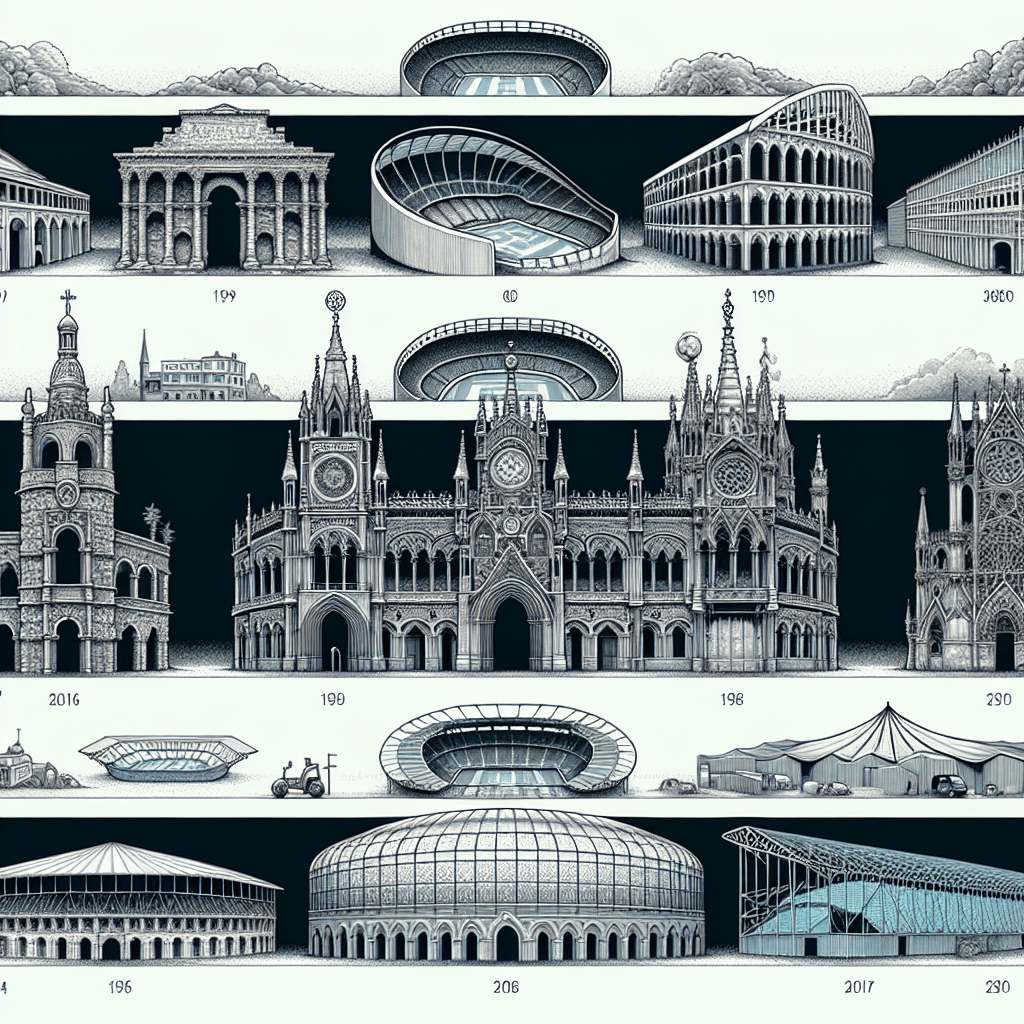[ad_1]
The Evolution of Soccer Stadium Architecture Through the Ages
Soccer stadiums have long been more than mere venues for hosting sports events; they are cathedrals of passion, symbols of cities, and landmarks of architectural innovation. The evolution of soccer stadium architecture is a fascinating journey that mirrors changes in technology, society, and the beautiful game itself. From the first rudimentary playing fields to the awe-inspiring arenas of today, soccer stadiums have evolved significantly, shaping and being shaped by the eras they emerged from.
The Early Days: Origins and Wooden Stands
The history of soccer stadium architecture can be traced back to the late 19th century when the sport began to gain popularity, particularly in England. Initially, matches were played on open fields without designated spectator areas. As interest grew, simple wooden structures were erected to offer spectators a basic viewing platform. These early stands were modest and functional, designed solely to provide a slightly elevated position from which to watch the game. However, fires were common, leading to tragedies such as the Bradford City stadium fire in 1985, prompting a reevaluation of materials used in stadium construction.
The Concrete Era: Safety and Expansion
The turn of the 20th century marked a significant shift with the introduction of concrete as a primary building material. This transition allowed for larger, more durable structures and the first wave of true soccer stadiums were born. The increased capacity not only accommodated the growing fan base but also captured the communal essence of soccer, transforming match days into major social events. Iconic stadiums like Old Trafford in Manchester, England (1910), and Estadio Centenario in Montevideo, Uruguay (1930), exemplify this era, with their expansive terraces and bowl designs emphasizing visibility and communal experience.
Post-War Modernism: Functionality and Aesthetics
The post-World War II era ushered in a wave of modernism in architecture, characterized by minimalism and functionality. In soccer stadium design, this translated into more refined structures with an emphasis on clear sightlines, comfort, and accessibility. The use of cantilevered roofs, such as those at the Estadio Azteca in Mexico City (1966), allowed for unobstructed views by removing the need for pillars. This era also saw the introduction of luxury boxes and enhanced amenities, catering to a broader range of spectators and generating additional revenue streams.
The Age of Multipurpose Stadiums
In the late 20th century, the concept of multipurpose stadiums gained traction. These venues were designed to host a variety of events, from soccer matches to concerts and athletic competitions. While economically beneficial, the compromise often came at the expense of the spectator experience, particularly for soccer fans, as sightlines could be less than ideal for the specific dimensions of a soccer field. Stadiums like the Stade de France, built for the 1998 FIFA World Cup, addressed some of these issues with innovative design elements that allowed for configuration changes to better suit each event.
The 21st Century: High-Tech and Sustainable Designs
Today’s soccer stadiums are marvels of technology and sustainability. Architects incorporate advanced materials and cutting-edge technology to create venues that are safe, comfortable, and environmentally friendly. The use of retractable roofs and pitches, sophisticated lighting and sound systems, and high-efficiency waste and water management practices exemplify the modern stadium’s dual focus on enhancing the fan experience and minimizing environmental impact. The Allianz Arena in Munich, Germany (2005), with its pioneering use of ETFE plastic panels for its facade, stands as a testament to the innovative spirit of contemporary soccer stadium architecture.
Stadiums like Tottenham Hotspur Stadium in London (2019) have taken the integration of technology a step further, boasting features such as retractable pitches and in-seat delivery services for fans. Furthermore, the drive for sustainability has led to the implementation of rainwater harvesting, solar panels, and wind turbines in stadiums like the Estadio Metropolitano in Madrid, Spain.
FAQs:
1. What was the first soccer stadium?
Ans: The first soccer stadium is considered to be the Bramall Lane in Sheffield, England, which hosted its first game in 1862. However, it wasn’t built as a dedicated soccer stadium and also hosted cricket matches.
2. Why have soccer stadiums evolved to incorporate retractable roofs and pitches?
Ans: Retractable roofs and pitches enhance the versatility and usability of a stadium, allowing it to host a range of events in different weather conditions without damaging the playing surface. These features also improve the spectator experience, offering comfort and uninterrupted views regardless of climate.
3. How do modern soccer stadiums address safety concerns?
Ans: Modern stadiums are designed with a strong emphasis on safety, featuring advanced evacuation procedures, crowd management systems, and surveillance technologies. Materials and structural designs are also subjected to rigorous testing to prevent collapses or fire hazards.
4. Can soccer stadiums truly be environmentally friendly?
Ans: While large structures like stadiums inherently require significant resources, many modern venues are designed with sustainability in mind. They incorporate renewable energy sources, efficient waste management systems, and sustainable materials, significantly reducing their environmental footprint.
5. What’s the future of soccer stadium architecture?
Ans: The future points towards even more technologically integrated, flexible, and sustainable designs. Virtual reality experiences, drone food and merchandise delivery, and the use of bio-based materials are just a few of the innovations that may define the next generation of soccer stadiums.
The journey of soccer stadium architecture from simple wooden stands to the high-tech, multi-purpose arenas of today reflects not only advancements in construction and design but also the changing needs and values of societies around the world. As we look forward to the future, one thing remains certain: the evolution of soccer stadiums will continue to inspire and amaze, just like the game played within them.
[ad_2]






